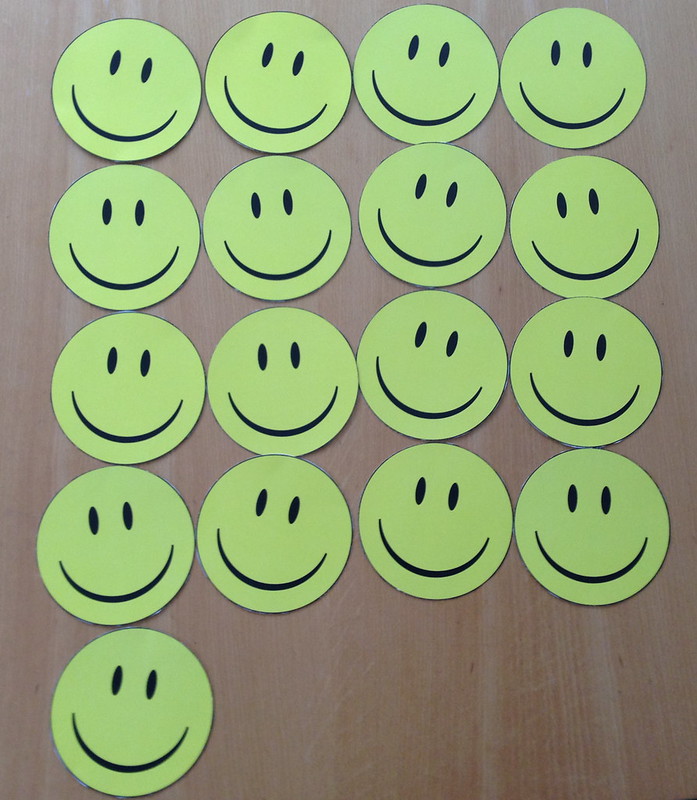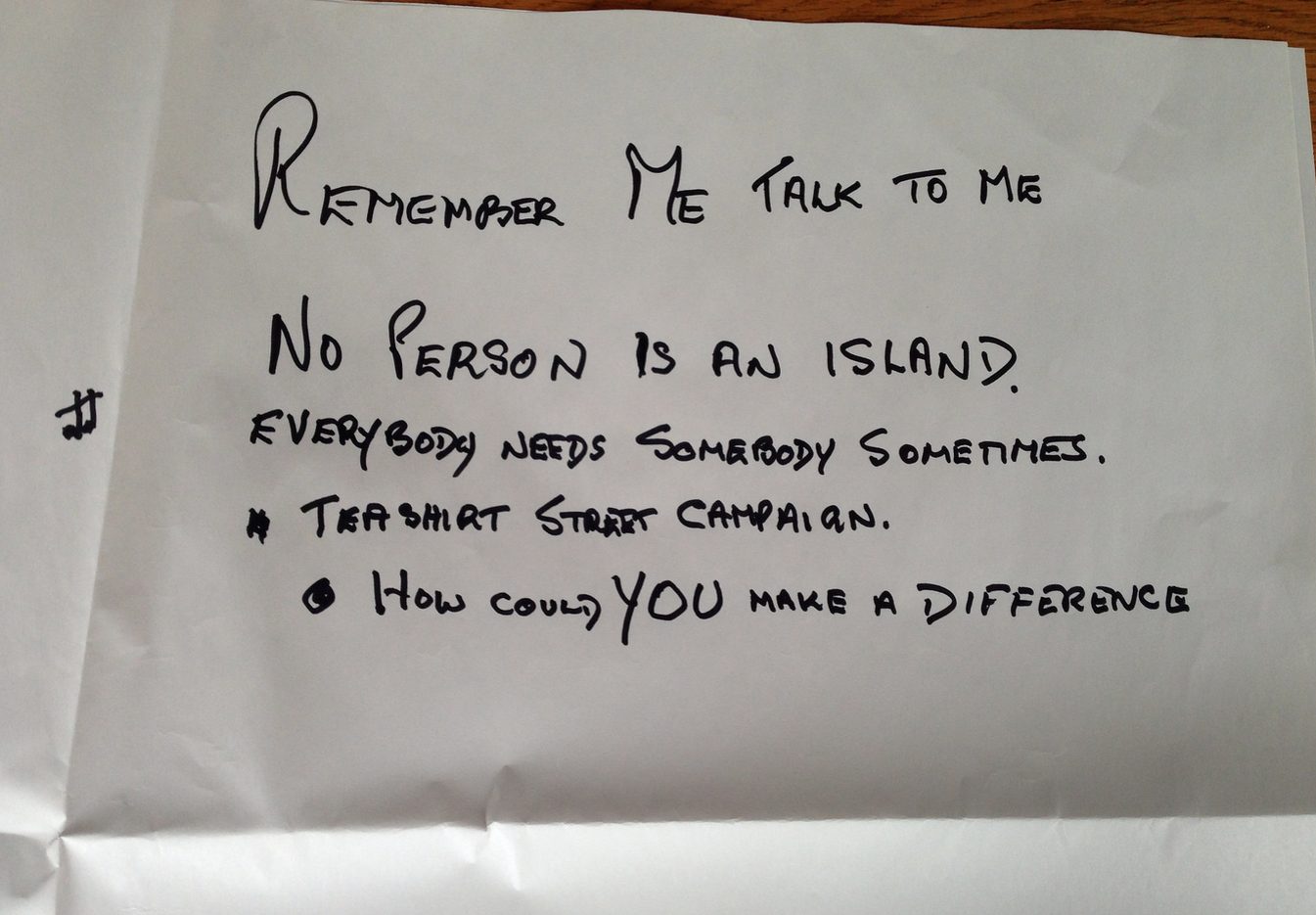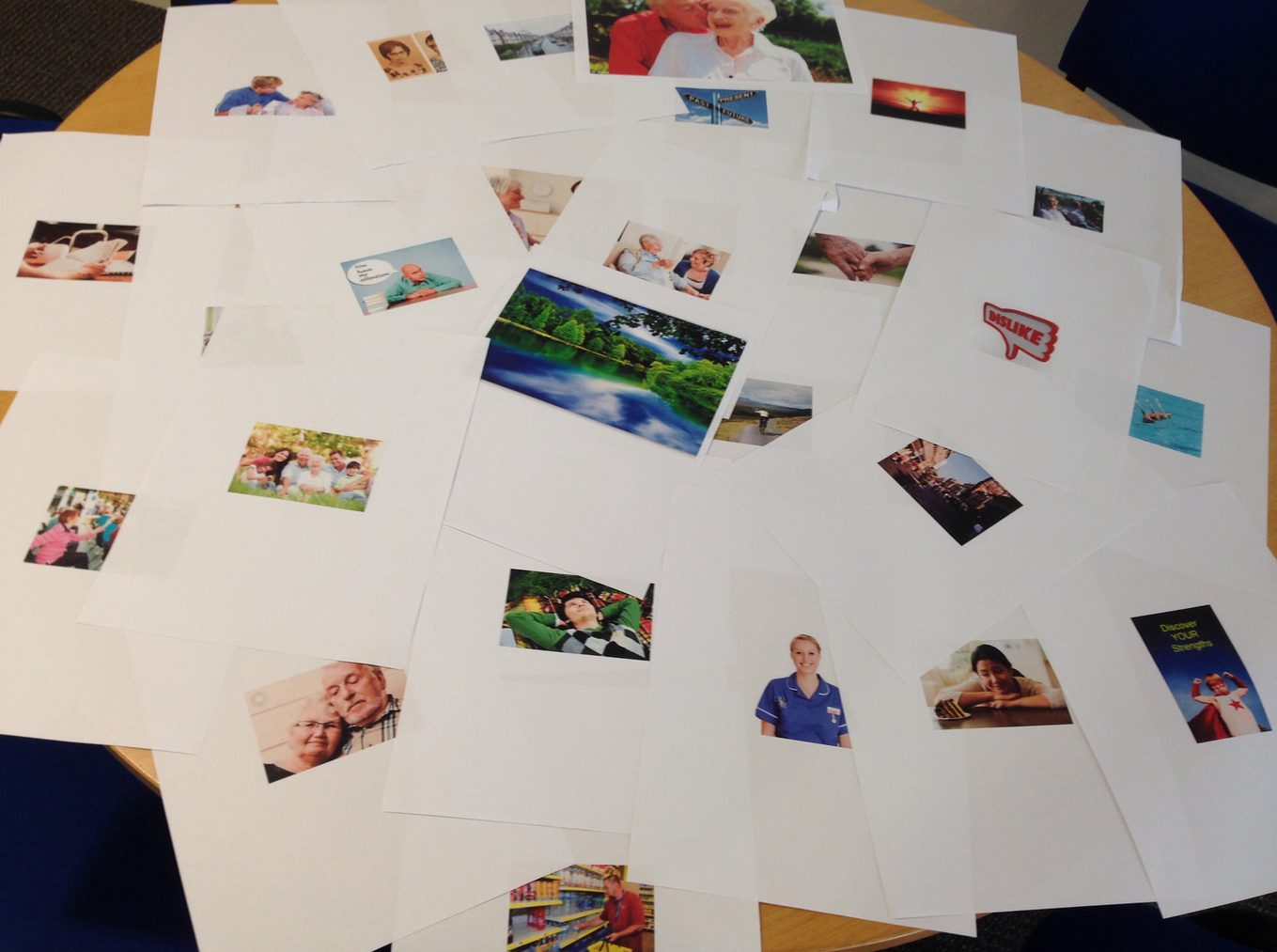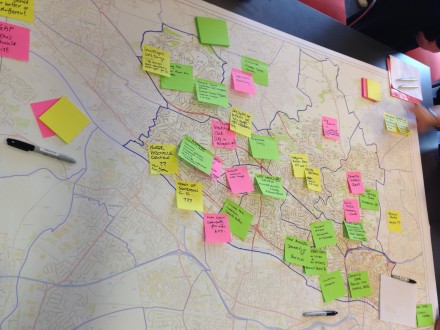This was the workshops when the group moved from understanding, to planning what they were going to do in repsonse to the needs they had identified. This was our programme for the day and we decided our goals would be to:
- Complete community mapping (from last meeting)
- Introduce approaches to improvement
- Develop improvement ideas to trial
- Agree homework and next steps
Connecting up
For homework, people had been asked to identify 12 songs or pieces of music that were particularly meaningful to them, and say why. We shared the chosen songs as part of our ice-breaker using spotify and Youtube. Everyone loved this! As you’d expect, it also identified diverse tastes in music. Some people shared memories that related to the songs they had chosen.
This is an example of one of the musical templates filled in by a group member.
Recap on person-centred care and support
We felt it was important to ground people in what was understood by person-centred care and support before moving on to identify improvement ideas we wanted to trial. At the previous meeting we had devised a task where groups designed their own campaign. We re-capped this work and re-played the videos of the groups presenting their campaign ideas. Below are the thoughts from each of the three groups, recorded on flip chart paper and a summarising their ideas.
The power of pictures
We also used images to encourage the group to think about the meaning of person-centred support. We gave people a choice of 20-30 images and asked them to choose one that ‘spoke to them’ about person-centred care and support. Most communication, as we know but can forget, is non-verbal. It includes gestures, facial expressions, eye contact, body language and touch, but it also includes pictures.
After people had chosen a picture, we asked them to share what it meant to them.
Revisiting community mapping
We took the group through new additions to the map that they found as part of their homework. We felt this was important and decided to take our time over any new addition to the map. We didn’t want to overload the group with too much information in one go.
Introducing approaches to improvement
This video ‘Leadership from a dancing guy‘ is thought-provoking and identifies certain lessons, including the importance of followers. Key things the video highlights are:
- A leader needs the guts to stand alone and look ridiculous
- A leader should be easy to follow
- A leader should embrace followers as equals (it’s about the movement, not you)
But leaders are also over-rated….
- It takes guts to be a first follower. It’s the first follower who transforms a ‘lone nut’ into a leader.
- A follower should be easy to follow too. They need to be public as new followers emulate the first follower, not the leader.
Soon you reach a ‘tipping point’ and have a movement as more people join in. Eventually those who haven’t joined in will be the odd ones out. Watch the film and see a movement happen!
We also guided the group through approaches to improvement, a powerpoint presentation, with notes, that we created. This presentation has key pointers about things to consider (and things to avoid) when trying to improve something. Thanks to Jason Leitch (Clinical Director, Quality Unit at Scottish Government) as his presentation at the National Learning Event (People at the Centre of Health and Care, on 27-28 May 2014 in Glasgow) inspired much of the content of this presentation. In summary this presentation notes:
- There’s always room for improvement
- Focus on what you can do, not what you can’t
- You choose how you respond to things (take control)
- Find enthusiasts to try out new improvements on (not those who are reluctant)
- Don’t start with a large test/pilot
- Don’t try and get one person to do it all
- Measure your improvement tests to find out of its been successful – do this often and feedback your results quickly
- Strong evidence for innovation is necessary but not enough to result in its adoption – you need to win hearts and minds
- Spread the improvement- pass the baton, find followers and new leaders
What we wanted to pilot/trial
Next, we split the whole group into 3 small working groups to develop ideas they wanted to trial. As usual, we wanted a good mix of professionals and non-professionals in each group. We asked each group to work through two stages.
Stage 1:
- Each working group to identify 2-3 improvement ideas
- Share with whole group – and identify any overlap
- Each working group to choose ‘ideas’ they want to work up (at this stage people could change groups if they felt they had more to offer another group – either expertise or enthusiasm)
Each group was provided with a template and notes to help them work up their ideas and get members of the group to action certain things that would help them move this on. We also provided them with a summary of things they had earlier said they wanted to achieve and ideas for improvement generated at earlier meetings, so nothing was lost. We asked each group to identify a scribe and reporter (to feedback) their ideas.
Ideas from stage 1
The groups considered the ideas identified in earlier meetings. Then, building on learning from the community mapping exercise and motivated by what people wanted to achieve, the following ideas were identifed:
- Meeting for carers alone. There is a meeting in Scotstoun and one at COPE but nothing in the evening. This should provide peer support and be confidential – without ‘expert’ leaders. It was seen as an natural outcome from this group, with others invited to join.
- More local dementia cafés.
- Rugby reminiscence/sport other than football- could be golf or boxing in club premises.
- More stimulating activities in centres eg fitness focus, leisure activities, pool table and opportunities for people to use their trade/skills.
- Want to play games and music all year. West end concert hall – what about the bandstand?
- Healthy Food Café at Annexe (Partick) but would be good to have this elsewhere too. What kind of diet is good for us? In fact, another place like the Annexe would be good.
- Nice green places with benches.
- Increase dementia volunteers/befrienders in NW Glasgow. Support for getting people out of the house so not isolated. People don’t necessarily need paid home support, but befriending. Some people don’t like attending groups. Believe they could easily fill any spots. Could model on Dementia Friends – a network of volunteers developed in England, but extending north to Scotland through Alzheimer Scotland.
- Ask children in school to volunteer to help? Part of awareness raising around dementia. Also make sure older people get invited to school plays.
- Fire and rescue safety checks- training with fire service staff.
- More Dementia Champions, extending it from where it started in acute hospitals – for local community eg targeting pharmacies and/or targeting private sector care workers who come into peoples’ homes). (Referred to as Dementia Ambassadors in social work).
- A searchable online database/local asset map that can be individualised to support people to do the things they want to do (lined to personal outcome planning/Talking Points). ALISS or visual Pinterest-type models suggested. Would require pooling of knowledge and commitment of all to maintain.
Each working group chose to focus on one of these ideas:
- A dementia café to run fortnightly in a local venue
- Volunteer/befriending scheme in NW Glasgow (failing that would consider more Dementia Champions targeting people in community and private sector care workers; or searchable online database/local asset map that can be individualised and linked to someone’s personal outcomes)
- A new local carers group that is confidential and not run by ‘experts’ as a natural outcome from this group that can be extended to others
Stage 2:
Each group was asked to be responsible for organising a meeting between this meeting and the next in October in order to further develop their idea. We asked someone in each group to volunteer to coordinate this meeting. Thanks to Laura K, Katherine and Helen.
We offered to provide neutral meeting space if required, but no one seemed to need this. One group had already found a date and were meeting at a group member’s house.
Homework and actions
The homework arose from the actions identified by each group in the ‘what we want to pilot/trial’ activity.
People were also asked to support the Playlist for Life’s i-pod donation drive which aims to collect donations of iPods to be given to people who want to create a playlist. We provided a donation blurb that was free to use (or not) when telling people about this drive.
Feedback and evaluation
We got a response of 17/17 smiley faces to describe how people felt at the end of the day (with happy, unhappy and not so sure options provided).
What went well?
- ‘All geared up to change the world!’
- Proactive and enthusiastic
- Format for the day varied and interactive
- Fun- especially the music
- Desire to pick the best ideas and move on
- Having a plan/template for each idea helped us be more concrete
What didn’t go so well?
- TV hard to hear (for person-centred campaign play back)
What will you take away?
- Work to take away (actions)
- Excitement
- Good to know we will see each other before the October session
What are you learning?
- Good ideas and push to move things forward
- Tackling subjects practically
- People’s confidence building






